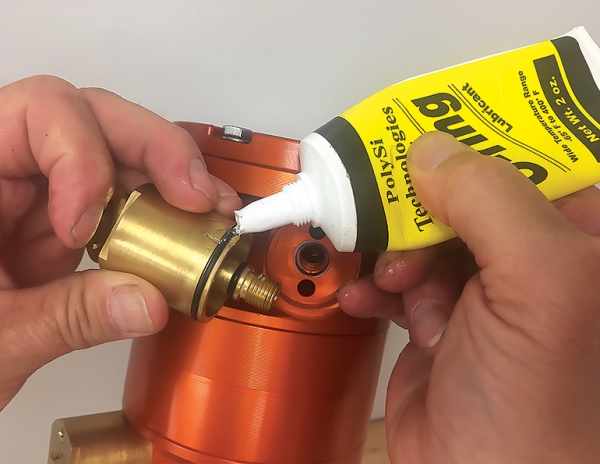The last few seasons have shown resorts across the country the importance of effective and efficient snowmaking. One aspect of that, of course, is effective and efficient equipment. But just as important is maintenance.
Maintenance also serves an important third purpose. “Our three main goals/reasons for performing maintenance are: safety, efficiency and reliability,” says SMI’s Brooke VanderKelen. “Maintaining equipment helps ensure the safety of your team and customers while allowing your equipment to be ready when you need it.”
Maintenance could be especially important in regions that were hit hardest by drought and warm temperatures last year, where systems may not have been put to bed properly. For them, coming out of the box with all guns blazing could be crucial this coming season.
But maintenance is important for every area. “Windows for snowmaking are getting shorter. We see it in the data drawn from our computerized systems,” says Robin Smith of TechnoAlpin.
“Our customers are focused on maximizing snow production in every available window,” adds Charles Santry of HKD. “All aspects of the snowmaking system, including the machinery, piping network, and snowgun technology, have to be ready to go at a moment’s notice. A thorough maintenance plan sets the system up for success on day one.”
BITE THE BULLET
This takes a commitment from the top. Managers might prefer to wait until the last minute to bring on the snowmaking power, to keep costs in check. But the resulting “live fire” testing can lead to season-opening frustration and delayed production. “You maintain machines so that when the time comes to push the button, it starts, it runs, and operates with maximum efficiency in the critical marginal operating conditions. There are no shortcuts in doing it the right way and being thorough,” says Ed Dietzel of MND.
So: How to control costs? A few power companies will waive the demand charge in the name of testing, but you have to ask. If that’s not possible, break demand for snowmaking one month early, and use the smallest load needed to test all the equipment—such as pumps and compressors—one piece at a time. Coordinate with lifts and other summer attractions if there is a common meter, to avoid new load at the same time.
What to do? Test all critical components and check for air and water leaks. Equipment that’s outdoors in summer—hoses, guns, hydrants, pipe, cabinets, control panels—may become home to bees, hornets or rodents; clear them out before firing up the equipment. Was there an excavator doing anything on your mountain this summer? Other departments and contractors may have caused unintended damage.
“You should pressurize your system, with tower snow guns in ready position, and clean any clogged nozzles, replace any defective nozzles or snow gun parts, and check nozzle wear,” says Ron Ratnik.
On first start up, “flush the hydrant until it runs clean water before connecting it to the gun,” Smith adds. “With steel pipe, rust and scale can choke clean filters and nozzles in an instant.”
To broaden your knowledge base, attend a vendor-sponsored training session. “That can be a great way to learn maintenance strategies and to connect with snowmakers from other resorts,” says HKD’s Scott Gunnell.
DO IT NOW
Maintenance work should begin as early as possible. “The earlier you can start, the more thorough you can be,” VanderKelen says. That allows even a relatively small crew to get a lot done, and provides time to order parts, if needed.
Some suppliers urge resorts to do a system test before shutting down at the end of the snowmaking season. “It’s best to check all guns and inventory then, while the system is in use, to identify any issues,” says Snow Logic’s Mitch Dodson.
Maintenance and spare part requirements are more evident when the technology is in operation; inspecting during the summer is more time consuming and labor intensive. This approach will streamline spare part replenishment, summer servicing and start-up preparations.”
Larchmont’s Joe Tropeano notes it can take up to nine months to get some compressor and pump parts, and urges resorts to do repair work in summer.
We thank SMI, Ratnik, MND/Sufag, HKD, TechnoAlpin, Larchmont, and Snow Logic for contributing to the guidelines below. You should, in all cases, follow your manufacturers’ specific recommendations.
Maintenance Items
Nozzles
The primary items to check are the water nozzles, nucleators and filter screens.
• Check for nozzle wear. This diminishes a gun’s output, and reduces its ability to make snow at marginal conditions, by requiring colder temperatures for start-up. Your snow gun manufacturer can tell you what the correct nozzle openings are for various sized nozzles.
Inspect for any obvious wear—orifice out of round, or enlarged—that would affect spray pattern, especially first stage that gets the most use, most important for marginal temperature operation. You can use round stainless steel pins to compare the original nozzle hole size to the current sizes and determine which nozzles should be replaced.
• Check for any debris or insect activity that blocks the nozzle or nucleators. Clean nozzles with a tip cleaner or fine wire brush; clean nucleators with tip cleaner, compressed air, or water.
• Check and clean any nucleators that have internal screens.
• Replace O-rings any time water is leaking from a nozzle.
Hardware Care
• Visually check tower brackets and other equipment. Ensure all parts of the gun move freely and there is no binding (i.e. handle, jack and post mount).
• Repair or replace leaking ball valves, air, and water hoses.
• Inspect snowmaking hoses; clean and test for wear. Inspect the connection of the cam lock coupling to the hose, and replace any fittings that are loose or look like they may come loose in the future. When reconnecting hoses at the beginning of the season, ensure all couplers are screwed on and seated correctly.
• To protect against rodents and insects, cover any openings, panels, fittings, etc., with strong plastic bags, industrial stretch wrap, Tyvek, etc.
• Inspect water hydrants. If there are people walking on the slopes during the summer, they may have turned on air and water hydrants. Ensure everything is screwed in and seated correctly.
• Pressurize the water distribution system; inspect, repair, and flush before connecting snowguns. If you have to dig, fall, not winter, is the best time.
• Inspect, clean airlines and filters.
• For mobile units, check tires for physical damage. You may need to install a new tube if the tire doesn’t hold air.
• Pumps, compressors, and electric motors should be maintained in spring. This helps avoid demand charges on the electric. Also, it can take several months to manufacture repair parts. A qualified electrician should test the electric motors, including pumps, compressors and other cooling equipment used for snowmaking. Electronic controls can be intimidating to all but the most experienced and highly trained resort staff.
AIR/WATER GUNS AND STICKS
• Check condition of couplers, out of round, missing ears, face gasket. Inspect any supply hoses that remain attached.
• Check and lubricate any crank or lifting mechanism. Ensure it operates all the way down and up, to access nozzle head for any service.
• Inspect boom and head for cracks.
FAN GUNS
• Check the fault history of the gun. If it failed last year, figure out why and correct the problem.
• Inspect water filters for damage to screen; check O-rings; and clean both as necessary. Replace O-rings on filters and manifold caps if needed, as they can crack and delay startup.
• Compressors: Change oil, check air filter. Inspect air supply hose for cracks, leaks and connections; any air leaks will affect operation of the nucleators. Test operation of pressure release valve.
• Check condition of rubber dampers, and that mounting bolts are tight.
• Electrical: Inspect power supply cord for damage. If you remove cords for the summer, check for proper phasing and motor rotation when re-installed.
• Inspect external control switches and protective covers. Check operation of all motors—fan, swing, compressor.
• Inspect wiring and control cabinets for any damage from use and abuse, water penetration, rodents or insects.
• Heat system: Check heat elements for any flammable debris, such as bird, rodent or insect nests. Check wiring for physical or rodent damage.
• Chassis: Inspect for any cracks, bent parts or other damage. Lubricate any pivot points. Check operation of leveling jacks.
• Inspect chassis, welds and bracketry for cracks or bends.
• Check fan props for cracks and missing pieces.
AUTOMATED EQUIPMENT
• Check accuracy of weather station and pressure sensors. Check the humidity on both low and high ends of the scale; in a low humidity environment, breathe into the sensor to check the high end.
• To protect equipment from lightning during the off-season, disconnect communication cables/wires wherever possible, open fuses and circuit breakers, and turn off main disconnects. If batteries are present for power fail hydrant closure, be sure that they are shut down properly to prevent damage. Reconnect equipment and perform operational checks in the fall.
• Perform any manufacturer’s equipment maintenance checklists.
• Verify communications between the machines and central computer.
• Check for proper operation of hydrant actuators.





